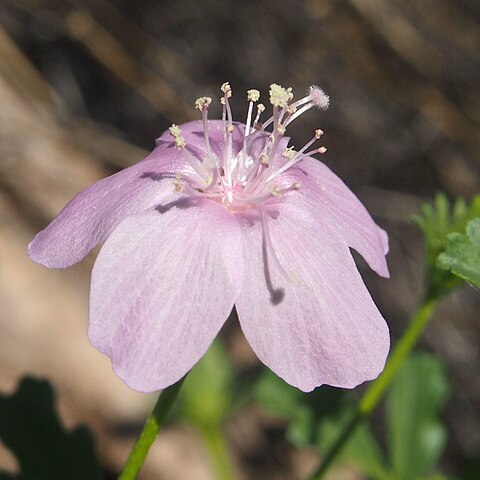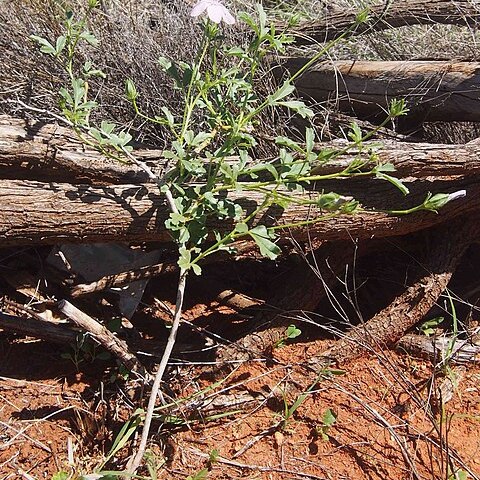Herb or subshrub to 0.1–0.5 m high. Branchlets with sparse to moderately dense scattered stellate hairs (0.2–0.7 mm wide), indumentum yellowish. Stipules at length deciduous, narrowly triangular to triangular, 2.3–4.2 mm long, 0.3–0.8 mm wide, indumentum like branchlet. Mature leaves: petiole 10–35 mm long, indumentum like branchlet; lamina broadly ovate to orbicular, unlobed, or shallowly lobed to the base (5-lobed), the lobes longer than wide, 12–50 mm long, 10–55 mm wide, cuneate, attenuate or rounded base, serrulate to serrate margin, obtuse to rounded apex, discolourous, indumentum more dense on abaxial surface, stellate hairs on abaxial surface sparse to moderately dense, hairs sessile, multiradiate with (1) 4–6 rays, the rays 1–1.5 mm in diam., indumentum similar on veins and interveinal regions, whitish to yellowish; distal leaves reduced in size. Flowers solitary in leaf axils; pedunculate, peduncle 25–120 mm long with stellate hairs; pedicel 3–5 mm long, with stellate hairs, broadening distally. Epicalyx segments 9–10, linear or subulate, 4.8–7.5 mm long, shorter than the calyx at anthesis, free or very slightly fused at the base, straight with recurved apices in flower and becoming fully recurved in fruit, with sparse stellate hairs and coarse bristles on the margins. Calyx 10–12 mm long at anthesis, enlarging to 17.5 mm long in fruit; lobes narrowly triangular, 6–10 mm long at anthesis, enlarging to 12.5 mm long in fruit, abaxial indumentum of sparse stellate hairs and coarse bristles on apical half of lobe, without prominent marginal ribs. Petals 10–19 mm long, adnate to staminal column at base but otherwise free, pale pink, purple, mauve or white, lacking basal spot, glabrous adaxially with very sparse stellate hairs abaxially, basally with a tuft of simple hairs between each petal, sometimes also with a few hairs on margin of petals. Staminal column 0.5–1 mm long, apex irregularly 5-lobed, with the stamens usually distributed singly along the distal 0.3–0.4 mm of the column; staminal filaments 3–5 mm long; anthers yellow, pollen yellow. Style 5-branched, with branches 4.8–6 mm long, exerted 5–6.2 mm beyond the apex of the staminal column, stigmas capitate, 0.5–0.7 mm wide, distinctly hairy, hairs c. 0.1 mm long, ovary hairy. Capsule ovoid, 10–12 mm long, glabrous or sparsely hairy with very few simple or stellate hair apically. Seeds subreniform, 2.5–3 mm long, with an indumentum of short pubescent hairs to 0.2 mm long, with a dark brown crescent-shaped hairless band of flank of seeds.
More
A low lying herb. It grows up to 60 cm high and spreads 30-100 cm wide. It has a woody taproot. The branches can be spreading or erect. The leaves are 1-2.7 cm long by 1-2.7 cm wide. They are broadly oval. Often the leaves have 3 lobes. The leaf stalks are 1-3 cm long. They are dark green and have coarse irregular teeth along the edge. The flowers are 3-4 cm across. They are bright pink. They occur singly in the axils of leaves. The flower stalks are 12 cm long. The fruit is a capsule 1-1.3 cm long by 0.9-1.2 cm wide. They are round and smooth. The seeds are hairy.


